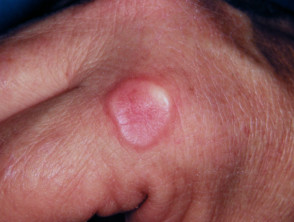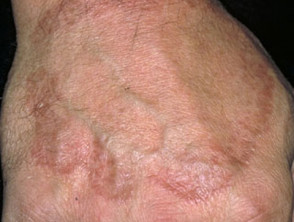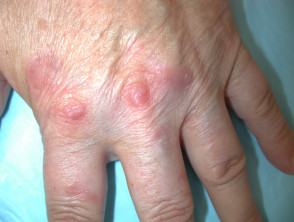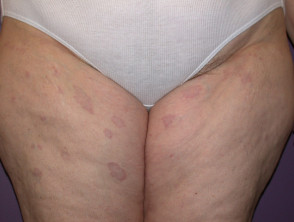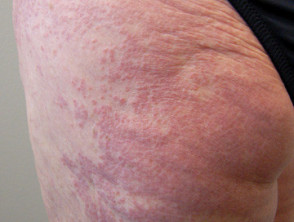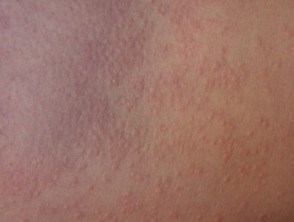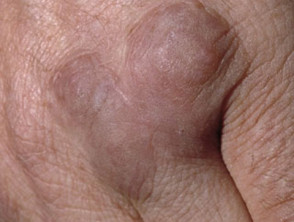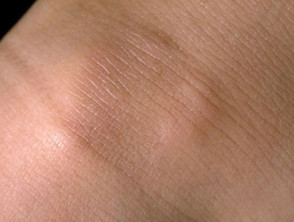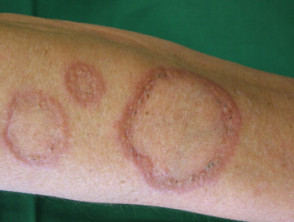What is granuloma annulare?
Granuloma annulare (GA) is a common inflammatory skin condition typified clinically by annular, smooth, discoloured papules and plaques, and necrobiotic granulomas on histology. Granuloma annulare is more correctly known as necrobiotic papulosis.
Who gets granuloma annulare?
Granuloma annulare is seen most commonly on the skin of children, teenagers, or young adults. The generalised form is more likely to be found in older adults (mean age 50 years). There is a female predominance of 2:1 over males.
What is the cause of granuloma annulare?
Granuloma annulare may be a delayed hypersensitivity reaction to a component of the dermis or a reaction pattern to numerous triggers. Reported triggering events have included many skin infections and infestations, and types of skin trauma. Inflammation is mediated by tumour necrosis factor alpha (TNFα). The reason this occurs is unknown.
There have also been a number of associations reported with systemic conditions including autoimmune thyroiditis, diabetes mellitus, hyperlipidaemia, and rarely with lymphoma, HIV infection and solid tumours.
What are the clinical features of granuloma annulare?
Granuloma annulare can occur on any site of the body and is occasionally widespread. It only affects the skin. Granuloma annulare may cause no symptoms, but affected areas are often tender when knocked. The plaques tend to slowly change shape, size, and position.
Localised granuloma annulare
The localised form is the most common type of granuloma annulare in general, and specifically in children. One or more skin coloured or red bumps form rings in the skin over joints, particularly the knuckles. The surface is smooth and the centre of each ring is often a little depressed. Localised granuloma annulare usually affects the fingers or the backs of both hands, but is also common on top of the foot or ankle, and over one or both elbows. Annular rings may be solitary or multiple, and grow outwards maintaining the ring shape before eventually clearing.
Localised granuloma annulare
See more images of granuloma annulare ...
Generalised disseminated granuloma annulare
Generalised granuloma annulare usually presents in adults, as widespread skin-coloured, pinkish or slightly mauve-coloured patches. The disseminated type is composed of small papules, usually arranged symmetrically in poorly-defined rings 10 cm or more in diameter. They are often found around the skin folds of the trunk (armpits, groin). Itch is common. This is the commonest form associated with HIV.
Generalised granuloma annulare
Subcutaneous granuloma annulare
Subcutaneous granuloma annulare is an uncommon form seen mainly in children. It presents as rubbery lumps (nodules) on scalp margins, fingertips, and shins. Subcutaneous granuloma annulare is also called pseudo-rheumatoid nodules because the subcutaneous lesions look rather like rheumatoid nodules; however, they do not arise in association with rheumatoid arthritis.
Subcutaneous granuloma annulare
Perforating granuloma annulare
Perforating granuloma annulare presents as yellowish plaques or papules on which a crust forms due to the elimination of damaged collagen through the epidermis. Perforating granuloma annulare is usually localised to the hands, but plaques may occasionally arise on any body site, especially within scars. Dermoscopy helps to confirm the presence of perforations in small papules within otherwise typical plaques of granuloma annulare. Perforating lesions are frequently itchy or tender. Perforating granuloma annulare is uncommon except in ethnic Hawaiians and in association with HIV. All age groups can be affected.
Perforating granuloma annulare
Atypical granuloma annulare
Atypical granuloma annulare describes:
- Granuloma annulare in unusual sites, such as the face, palms, and ears
- Granuloma annulare with photosensitive distribution
- Unusually severe or symptomatic granuloma annulare
Interstitial granulomatous dermatitis
Interstitial granulomatous dermatitis is a finding noted on histology in some patients with extensive granuloma annulare or other disorders with similar clinical presentation.
How is granuloma annulare diagnosed?
Granuloma annulare is usually diagnosed clinically because of its characteristic appearance. But sometimes the diagnosis is not obvious, and other conditions may be considered. Skin biopsy usually shows necrobiotic degeneration of dermal collagen surrounded by an inflammatory reaction. See granuloma annulare pathology.
Granuloma annulare is often initially misdiagnosed as tinea because of the annular appearance; the lack of surface scale should lead away from this and other scaly rashes such as discoid eczema or psoriasis. Actinic granuloma is considered by some to be a photo-aggravated variant of granuloma annulare, and by others to be a distinct entity.
What treatment is available for granuloma annulare?
In most cases granuloma annulare, does not require treatment because the patches disappear by themselves in a few months, leaving no trace. However, sometimes they persist for years. Treatment is not curative but may help individual lesions.
Local therapy
Options to consider include:
- Topical corticosteroid ointment under occlusion
- Intralesional steroid injections
- Destruction by cryotherapy or laser ablation
- Imiquimod cream
- Topical calcineurin inhibitors (tacrolimus and pimecrolimus).
Systemic therapy
Systemic therapy may be considered in widespread granuloma annulare. The following treatments have been reported to help at least some cases of disseminated granuloma annulare. None of these can be relied upon to clear it, and there are potential adverse effects.
- Systemic steroids
- Isotretinoin
- Methotrexate
- Potassium iodide
- Dapsone
- Hydroxychloroquine
- Pentoxifylline
- Allopurinol (note: allopurinol has also be cited as a cause of disseminated granuloma annulare)
- Combination of antibiotics once monthly: rifampicin, ofloxacin, minocycline
- Photochemotherapy (PUVA)
- UVA1 phototherapy (not available in New Zealand)
- Photodynamic therapy
- Ciclosporin
- Biologics particularly TNFα inhibitors such as adalimumab and infliximab
- Experimentally, oral and topical Janus kinase (JAK) inhibitors including tofacitinib
What is the outlook for granuloma annulare?
Individual lesions of localised granuloma annulare tend to clear within a few months or years, although they may recur even at the same site. Generalised and atypical variants are more persistent, sometimes lasting decades.
